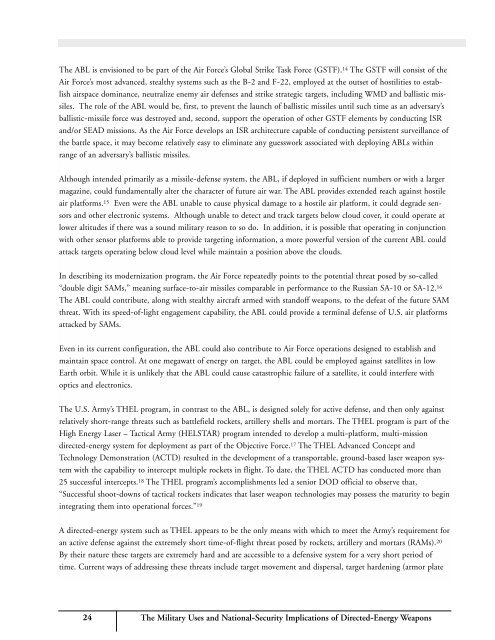directed-energy-weapons
directed-energy-weapons
directed-energy-weapons
You also want an ePaper? Increase the reach of your titles
YUMPU automatically turns print PDFs into web optimized ePapers that Google loves.
The ABL is envisioned to be part of the Air Force’s Global Strike Task Force (GSTF). 14 The GSTF will consist of theAir Force’s most advanced, stealthy systems such as the B-2 and F-22, employed at the outset of hostilities to establishairspace dominance, neutralize enemy air defenses and strike strategic targets, including WMD and ballistic missiles.The role of the ABL would be, first, to prevent the launch of ballistic missiles until such time as an adversary’sballistic-missile force was destroyed and, second, support the operation of other GSTF elements by conducting ISRand/or SEAD missions. As the Air Force develops an ISR architecture capable of conducting persistent surveillance ofthe battle space, it may become relatively easy to eliminate any guesswork associated with deploying ABLs withinrange of an adversary’s ballistic missiles.Although intended primarily as a missile-defense system, the ABL, if deployed in sufficient numbers or with a largermagazine, could fundamentally alter the character of future air war. The ABL provides extended reach against hostileair platforms. 15 Even were the ABL unable to cause physical damage to a hostile air platform, it could degrade sensorsand other electronic systems. Although unable to detect and track targets below cloud cover, it could operate atlower altitudes if there was a sound military reason to so do. In addition, it is possible that operating in conjunctionwith other sensor platforms able to provide targeting information, a more powerful version of the current ABL couldattack targets operating below cloud level while maintain a position above the clouds.In describing its modernization program, the Air Force repeatedly points to the potential threat posed by so-called“double digit SAMs,” meaning surface-to-air missiles comparable in performance to the Russian SA-10 or SA-12. 16The ABL could contribute, along with stealthy aircraft armed with standoff <strong>weapons</strong>, to the defeat of the future SAMthreat. With its speed-of-light engagement capability, the ABL could provide a terminal defense of U.S. air platformsattacked by SAMs.Even in its current configuration, the ABL could also contribute to Air Force operations designed to establish andmaintain space control. At one megawatt of <strong>energy</strong> on target, the ABL could be employed against satellites in lowEarth orbit. While it is unlikely that the ABL could cause catastrophic failure of a satellite, it could interfere withoptics and electronics.The U.S. Army’s THEL program, in contrast to the ABL, is designed solely for active defense, and then only againstrelatively short-range threats such as battlefield rockets, artillery shells and mortars. The THEL program is part of theHigh Energy Laser – Tactical Army (HELSTAR) program intended to develop a multi-platform, multi-mission<strong>directed</strong>-<strong>energy</strong> system for deployment as part of the Objective Force. 17 The THEL Advanced Concept andTechnology Demonstration (ACTD) resulted in the development of a transportable, ground-based laser weapon systemwith the capability to intercept multiple rockets in flight. To date, the THEL ACTD has conducted more than25 successful intercepts. 18 The THEL program’s accomplishments led a senior DOD official to observe that,“Successful shoot-downs of tactical rockets indicates that laser weapon technologies may possess the maturity to beginintegrating them into operational forces.” 19A <strong>directed</strong>-<strong>energy</strong> system such as THEL appears to be the only means with which to meet the Army’s requirement foran active defense against the extremely short time-of-flight threat posed by rockets, artillery and mortars (RAMs). 20By their nature these targets are extremely hard and are accessible to a defensive system for a very short period oftime. Current ways of addressing these threats include target movement and dispersal, target hardening (armor plate24 The Military Uses and National-Security Implications of Directed-Energy Weapons


